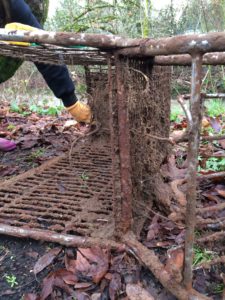Water Environment Services (WES) of Clackamas County funds Johnson Creek Watershed Council’s environmental outreach and service learning trips with schools in their district. JCWC’s Riparian Program Manager, Noah Jenkins, and Alexis Barton, the Outreach and Riparian Specialist, have engaged with students in WES’ district in various ways since the beginning of September. Have you ever been on a virtual watershed tour? Noah and Alexis visited Milwaukie High School to take them on one. A presentation that started at the peaceful headwaters of Johnson Creek journeyed down through various tributaries and notable areas around the watershed until its confluence into the Willamette. The ecology students were surprised to learn that the woody debris and rocky substrate now in the creek meant that, indeed, it is healthier and providing better habitat for the abundant wildlife of the watershed.
Virtual watershed tours aren’t the only way that WES is helping students connect to Johnson Creek. JCWC has worked with high school students from the Sabin-Schellenberg Center at a site known as Mystic Woods. Invasive Armenian (formerly known as Himalayan) blackberry was thriving right alongside the bank of Badger Creek, a tributary to Johnson Creek. Two classes in the Forestry Program came to help with restoration work, yielding several large piles of removed blackberry. Invasive species removal helps make way for the planting of native species, improving biodiversity and the health of the creek.
Students from Mt. Scott Learning Center, some of whom live in WES’ district, participate in monthly service learning trips with JCWC right along the main stem of Johnson Creek at both Mill Park (North Clackamas Parks & Recreation District) and the Springwater Corridor Trail from SE Linwood to Bell (Portland Parks and Recreation). During the beginning of the service learning trips, students gather data on the temperature, dissolved oxygen, creek depth, and the rate of the creek’s flow. In the spring, these students at Mt. Scott Learning Center will be studying environmental science, so the data collected now will be valuable for students to look back on, making the unit more relevant and engaging.

After water testing, students walk over to the Springwater Trail site for hands-on restoration work. Trash pick-up and invasive species removal are what the students will be focusing on until springtime. In November, students removed several different invasive species growing there (Armenian blackberry, clematis, deadly nightshade, and more). The shovels intended for digging out root balls were useful as students uncovered a fantastic trophy: a grocery cart partially buried, with the root balls of the blackberry tangled in the cart itself! The site will be planted in the springtime, after several more service learning trips through which students will have been a part of the planning process by prepping the site. Planting is the ultimate goal that students agreed upon on their very first visit. This is some of the students’ second or third year returning to this site and they have developed a sense of ownership there, and their goals of removing invasive species to make way for planting will contribute to the health of the watershed.
These various service learning trips and educational outreach to schools wouldn’t be possible without the funding provided by WES. By engaging students in service learning or education around the creek, JCWC is able to encourage young people to feel connected to their watershed and to care for their environment.
